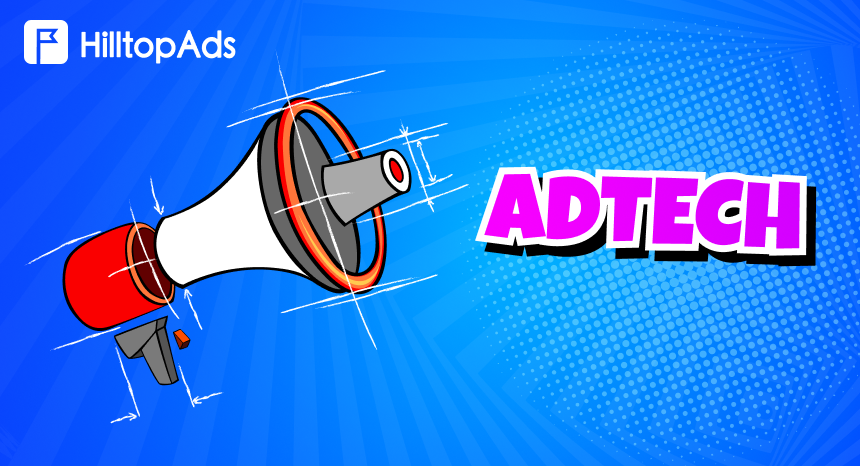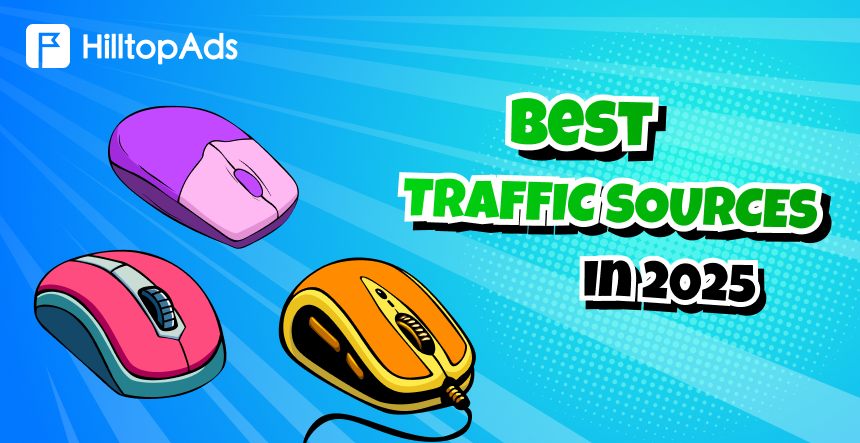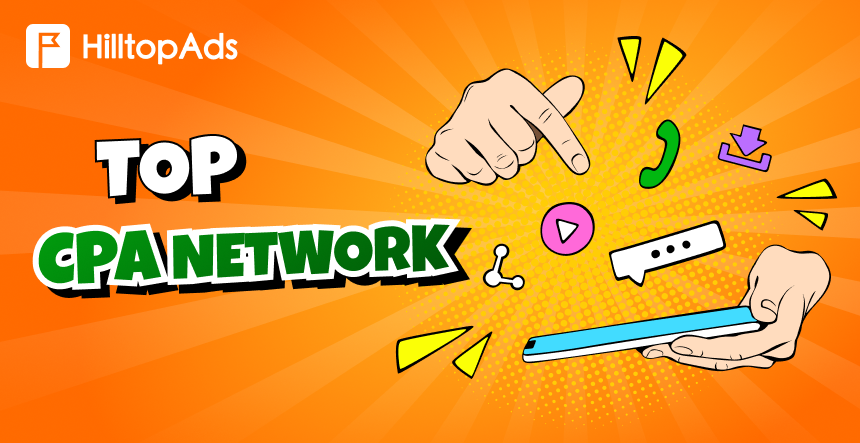Modern affiliate marketing is possible with a set of technologies called AdTech. Now, that’s a broad term that we need to elaborate on. Specifically, we will discuss RTB, programmatic advertising, the main actors, the pros and cons of AdTech, and what you can expect from the industry in the future. Without further ado, let’s dive right into it.

If you’re ready to grow your business with AdTech
it’s worth turning to the professionals at HilltopAds for support
Unlike tangible ads on billboards, digital ads don’t need to have a designated ad spot to be successful. Sure, eventually you’ll have to pick one, but thanks to the advancements in algorithms and infrastructure, it’s possible to unite all the ad inventory in a few hubs where auctions take place to determine which ads will be shown.
What Is AdTech
Before delving into the specifics, it is essential to understand the term in general. AdTech, or advertising technology, is an umbrella category of tools and software that help advertisers streamline their work. Affiliate marketing is a tricky business, with too many intermediary parties and data to handle on your own, so it is essential to use AdTech to stay afloat.
AdTech provides valuable data on customers’ online behaviors, automizes and optimizes advertising campaigns, includes demand-side and supply-side platforms (DSP and SSP; more on them later), and helps allocate budgets and maximize return on investment (ROI).
Advertising perfectly encompasses the quote, “The right man, in the right place, at the right time, can steal millions.” AdTech can help you be this man by saving time and valuable resources, streamlining research and campaign development, and providing customers with personalized content — everything without stealing a dime! All the money gained is earned here.
AdTech is the set of tools and platforms that make digital advertising work. Instead of buying ad space directly from a website, algorithms decide which ad should be shown to which user at the right time. Early models used the so-called “waterfall” auctions, where demand sources were prioritized one after another. Today, it’s mostly about real-time, data-driven decisions powered by exchanges, DSPs, SSPs, and measurement tools.
What Programmatic Advertising Is and How It Fits Into AdTech
When talking about AdTech, you can’t ignore programmatic advertising, which we will explain in this section. Programmatic advertising is an automated process of purchasing and selling digital ad inventory from across the web, social media, apps, and so on. Usually, media buyers run programmatic campaigns on demand-side platforms that allow advertisers to buy ad placements online in real-time. The best thing about programmatic ads is that they use machine learning algorithms, which means they identify audiences based on demographics, shopping patterns, and other data to deliver the most effective ads at the right time.
Like AdTech, programmatic advertising is a broad term for the automated process of buying and selling digital ad space. The most popular method here is real-time bidding (RTB). RTB is an auction where participants, as the name implies, bid in real time for individual ad impressions, which contain valuable data about the user, like demographic, location, and browser history.
HilltopAds also takes part in Real-Time Bidding and reserves premium ad spots for you to buy. That’s the key to working with our Ad Network: we provide the best ad inventory affordably, and you can tap into it relatively hassle-free. RTB platforms are crawling with marketing sharks, but we protect you from unfair competition and give all the tools needed to both aspiring and seasoned marketers. Try out our platform now to start your digital marketing journey.
Programmatic advertising automates the buying and selling of digital ads. Real-Time Bidding (RTB) is the most advanced version of it: every time a user loads a page, advertisers bid in milliseconds for the impression. The winner’s ad gets served instantly, making the process efficient and highly targeted. But it’s not just about RTB. There are also programmatic direct and preferred deals, which give advertisers guaranteed access to premium inventory. This flexibility is what makes AdTech much more than just “auctions”.

Sign up with HilltopAds and get the best ad inventory at an affordable price
How Does AdTech Work
Now that we have gone through the basics, it’s time for us to combine the pieces into a bigger picture and understand how AdTech works in practice. Let’s look at this hypothetical example:
- A person visits a news website, which triggers the available ad space to send this user’s relevant data and a request to show an advertisement to various DSPs.
- An Ad Exchange algorithms conduct an auction, analyzing the data on the campaigns prepared. Once the match is found, the campaign becomes eligible for the auction, and the bid is made.
- And finally, the winner’s ad is displayed for the potential customer.
Everything described here happens in a fraction of a second, and the process repeats billions of times throughout a day.
Read our new article about the Best Traffic Sources in 2025:
Key Players in the AdTech Ecosystem
At this point, we already know a lot about AdTech and how it works in real life, so it’s time for us to look behind the scenes and examine the players and key terms.
Advertisers
They are the ones who buy advertising spaces on websites, apps, or social media to promote different products and services. They can work for a certain company or be a third party who does marketing for them. Their work includes creating advertising campaigns, analyzing data to choose the best platforms and audiences for their ads, and managing said campaigns to reach the set goals.
Publishers
While advertisers buy ad spaces, publishers sell them. Publishers can be website owners, social media bloggers, podcast producers, video creators, or app developers. Depending on their size and popularity, the audience and advertising space could be the publisher’s main source of income, so they do their best to manage their platforms and fill them with content that attracts users in bulk.
Ad Agencies
Those are the companies that specialize in planning, creating, and supervising marketing campaigns till the end for their clients. Advertising Agencies are helping with search engine optimization (SEO), data analysis, web design, and so on. Moreover, Ad Agencies utilize AdTech platforms to assist their users with programmatic campaigns, like negotiating and placing ad inventory.
Agency Trading Desk (ATD)
The Agency Trading Desk is a specialized department within an Advertising Agency that assists its clients with media buying and planning. Instead of managing this process through a DSP on their own, advertisers can reach out to ATD and get expert help and guidance in their programmatic campaigns.
Ad Networks
Think of them as a bridge between publishers and advertisers. Instead of media buyers reaching every webmaster they wish to work with one by one, Ad Networks simplify the “communication” process by collecting ad inventory and distributing it into different categories, like website type, users’ demographics, and type of content. To perfectly match advertisers and publishers, Ad Networks use algorithms.
AdTech Companies
The name here speaks for itself; these companies create everything AdTech-related to simplify the digital marketing process. Optimization and automation software, data management, audience targeting — all this and even more are the merits of AdTech companies.
Demand-side platform (DSP).
As we learned earlier in this article, DSPs are platforms where media buyers can run programmatic campaigns to buy advertising spaces. Through DSP’s interface, advertisers can change campaign settings in real-time based on performance and manage multiple Ad Exchange accounts.
Supply-side platform (SSP)
SSPs help webmasters to manage and sell their ad inventories. With SSP, publishers can list their advertising spaces across multiple Ad Exchanges and efficiently sell them through automated RTB auctions.
Ad Exchange
Just like Ad Networks are bridges between media buyers and webmasters, the Ad Exchange connects DSPs and SSPs. This is a neutral and transparent platform, where publishers can expect the best price for their advertising space, and advertisers have full control over their bidding strategies, so they can reach their target audience with precision.
What Are the Pros and Cons of AdTech?
So far, AdTech seems like a great thing: it streamlines the workflow, automizes the process of buying and selling advertising inventory, helps to allocate your budget properly, and so on. But nothing in this life is one-sided, and AdTech has its downsides, too. In this section, let’s look at all the pros and cons closely.
Pros:
Automation
Previously, every step of buying and selling ad spaces had to be done manually, one by one, from research to approval. Now, this job is done by algorithms, so you can dedicate more of your time to scaling.
Budget optimization
With AdTech, you can forget about general advertising, when a lot of people see your ads, but very few actually buy what you sell. With the introduction of machine learning, you can be sure that your ad will reach a smaller target audience, but with higher percentages of sales.
Data-driven decision-making
Advertisers can create more precise marketing campaigns because of technologies that collect and analyze vast amounts of data, providing strategic insights on how and when to reach the target audience.
High speed
By leaving the manual processes to machines that analyze information and bid on auctions in milliseconds, media buyers have more time to scale and refine their advertising campaigns.
Increased ROI
In the early days of digital marketing, the industry was broader and more speculative, but with the emergence of AdTech, the business became precise and targeted, which impacts the return on investment positively.
Cons:
Data privacy and security
While privacy isn’t a bad thing on its own, it can be troublesome in the context of AdTech. Programmatic advertising relies heavily on cookies to create more personalized ads, but a lot of users now oppose the collection of personal data, and recent changes in the policies of huge tech companies work in their favor.
Ad blockers
For regular users, AdBlock software simply blocks advertisements; however, it is much more harmful to the ecosystem than it seems. Ad blockers not only cut the revenue for publishers and advertisers but also degrade the quality of data, returning the industry to the time of broad marketing and increasing the costs for each campaign.
Fraudulent activities
Due to AdTech’s complexity, it is very susceptible to bad actors, who can cover their fraudulent activities behind the layers of different processes. For example, one scheme involves using bots that increase traffic, which makes advertising inventory on a publisher’s platform more desirable, forcing prices for ad spaces higher than they actually cost.
As we said earlier in this section, everything has its good and bad sides. If you think about it, none of the cons described here are exclusive to AdTech, and can be seen from time to time in the digital advertising industry as a whole. This might be a turn-off for some people, but if you understand the risks and still want to be a media buyer, you will be able to make the most out of AdTech’s pros despite some disadvantages.
The advantages of AdTech are: precision targeting, automation, scalability, and performance measurement. Drawbacks: complexity, fraud risks, privacy concerns, and reliance on third-party data. Compared to offline advertising, AdTech offers unmatched efficiency and control, but it also requires constant adaptation to fast-changing rules and technologies.
Start work with HilltopAds and get
- Advanced targeting options
- Direct traffic sources
- Self-serve platform
- Fully-managed service
- Postback tracking
Trends in AdTech
AdTech is driven by innovations and new technologies, so before we end, let’s take a look at what you can expect from this ecosystem in the future, and what is already making serious strides today:
Artificial Intelligence
AI is creeping its way into every part of our day-to-day lives, so it’s only natural that AdTech would have it implemented in some shape or form. AI can be used not only to generate creatives but also for data analysis, campaign optimization, and advanced audience targeting. The list of what AI can do is already huge, and considering how fast this industry evolves, we can expect that in the near future, almost everything in AdTech will be done with the help of artificial intelligence.
Cookieless targeting
AdTech companies are working hard to strike a perfect balance between not gathering users’ personal data and still creating personalized ads. They have already made huge progress with contextual targeting and are using Google’s Privacy Sandbox.
Connected TV (CTV)
In spring 2025, streaming already dominated almost half of the TV market: 44.8% against a combined 44.2% of broadcast and cable. Connected TV, which is also called over-the-top (OTT), provides huge opportunities for media buyers to create more personalized ads to show between the shows. Another bonus of CTV is that platforms like Netflix, Prime Video, or Disney+ can be watched on multiple devices, giving you more context on what and when your potential customer wants to see.
Digital out-of-home (DOOH) advertising
Whether you live outside Ebbing, Missouri, or not, you have seen many traditional billboards throughout your life. The problem with this type of advertisement is that it requires a lot of manual labor: selecting each billboard one by one, speaking with owners, waiting till the crew of workers comes and changes the old ad with yours; this is everything but the automated nature of AdTech. Gladly, physical ad spaces with digital screens are becoming more common, and with the help of AdTech, your ads can be seen by the entire city. Yes, DOOH-advertising is not for everyone, because there are some ads that you can’t show in public places, and the entire type is less targeted, but you can use other things to your advantage, like time of day or weather.
AI is already reshaping campaign optimization, creative generation, and audience segmentation. We also see more immersive formats with AR and VR, plus conversational ads via chatbots. Privacy regulations will push the industry toward first-party data and consent-driven models. The next big shift could be fully cookieless targeting powered by AI prediction.
Read our new article about the Top 15 best CPA networks:
Conclusion
It might not do everything for you, but it makes your job as a media buyer significantly easier. AdTech analyzes the data, so you can better understand your customer, automates manual processes, saving you time and power for more important tasks, and helps you to make the most out of your budget. What was previously a job for a whole team of marketers, AdTech has turned that into work for one person.
However, AdTech is too huge and complex industry to fit everything into one article. But you can be sure that this guide gave you everything you might need before diving deeper into the AdTech industry.
If you want to learn more, you can check out other articles dedicated to programmatic advertising, what the best sources of data are, and how you can benefit from marketing AI in our blog. And don’t forget, no matter how hard the business may be, with a reliable partner like HilltopAds by your side, you will emerge victorious.
FAQ: What is AdTech
In this section, you can find some of the most popular questions regarding AdTech and answers to them.





















